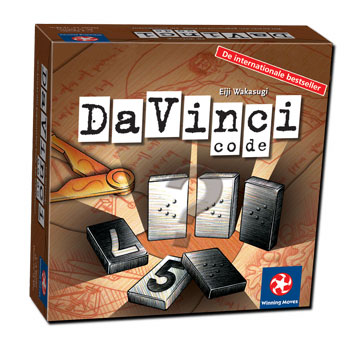
Game

The goal of the Da Vinci Code game is to reveal all of your opponents' secret codes before they uncover yours. Each player begins by drawing three or four (depending on the number of players) numbered plastic tiles from a face-down pile. After each player lines up the tiles in numeric order so that only he or she can see them, play begins.
On your turn, draw a new tile from the face-down supply and set it to the side of your lineup. Choose a tile in any opponent's array, and then attempt to identify it (e.g. "This is a Dark 3."). If you're correct, the opponent reveals the tile. If you're wrong, you must show the tile you drew from the pile and insert it into your lineup, in sequential order. As long as you make correct guesses, you can keep guessing additional tiles. If you decided to end your turn before making an incorrect guess, you can add the tile you drew into your lineup without revealing it, making your code longer.
Description
- The game can be played with 2- 4 players
- Two sets (one black and one white) of numbered tiles from 0-11
- One game takes about 20 minutes
Set-up
The tiles are put on the table face down and are mixed thoroughly.
Each player takes 4 tiles (or 3 if four people are playing) and puts them in front of them, the numbers facing towards them. The tiles must be numerically ordered from left to right. If two tiles have the same number the black tile will count as being the "lower" tile.
Gameplay
1. On your turn, begin by drawing any one of the remaining tiles. Make sure only you can see what is on the tile, do not place the tile in you own lineup yet.
2. Next, you must try to guess a number in an opponent's code. You may choose any opponent you wish. To do so, point to a specific tile and say what you think it is.
If you are correct, the opponent must place its tile so that everyone can see its identity.
If you are wrong, you have to place the tile you drew and then insert it face-up (so all opponents can see it) into your code in its correct position. By so doing, you give your opponents clues about the identities of your hidden tiles.
3. As your turn continues, if your first guess was correct, you may go again -- that is, you may continue your turn by attacking "any" other opposing tile. Or, you may decide to end your turn. If you end your turn, insert the tile you drew at the outset of your turn into your code. Do not show it to your opponents. Leave it standing. Your secret code is now longer by one tile.